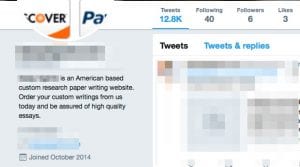5 Uncomfortable Truths About Plagiarism
Things that make you go... ugh...
 When it comes to plagiarism, there’s an understandable desire to bury our heads in the sand.
When it comes to plagiarism, there’s an understandable desire to bury our heads in the sand.
We don’t want to believe plagiarism exists. If it must exist then we don’t want to believe it’s that common. If it’s that common then it can’t be that bad. If it’s that bad, there must be a way to stop it.
Unfortunately, plagiarism does exist, it is common, it is unethical and there’s no 100% way to stop it.
But even if you accept those facts, there are still a lot of truths about plagiarism that can be tough to accept.
While none of those will be surprises to those who deal with plagiarism regularly, they’re still tough truths that many wrestle with, especially for those either new to the subject or those who deal with it less regularly.
Truth 1: Most Plagiarisms Aren’t Caught
 In the age of plagiarism detection software and an eagle-eyed public, it might seem that there’s no place for a plagiarist to hide.
In the age of plagiarism detection software and an eagle-eyed public, it might seem that there’s no place for a plagiarist to hide.
However, the truth is that most plagiarisms aren’t caught, at least not timely.
The reason isn’t because the technology is flawed or readers have poor memories, but rather, because there’s so much to read and so little is actually checked.
Sure, any piece of text can be checked for matching passages, but many schools and publications don’t bother using the tools at all. Those who do often use it in a spotty fashion and, even when it is used consistently, it’s still to easy to ignore or misinterpret results.
Take for example journalism, which has been mired in plagiarism scandals in recent years but has still steadfastly refused to use plagiarism detection software.
Whether it’s expense, time or effort that’s lacking, plagiarism checking is limited and that allows a large number of plagiarists to easily fly under the radar. Sure, any plagiarists that copies often enough will be caught eventually, but the odds of any one plagiarism being caught is still low.
Considering Jonah Lehrer had been plagiarizing flagrantly for years before being caught, it’s clear just how easy it is for a plagiarist to hide in plain sight.
Truth 2: Most Plagiarists Are Repeat Plagiarists
 An extension of fact one, once a plagiarist is caught, it can probably be assumed (though not always proven) that they had plagiarized in the past.
An extension of fact one, once a plagiarist is caught, it can probably be assumed (though not always proven) that they had plagiarized in the past.
Pop culture likes to paint a narrative of a good student or writer who was tempted to the dark side by a time crunch or a particularly difficult assignment.
However, if we accept the first truth, the second must be that any plagiarist who is caught has likely plagiarized in the past.
While it may be a situation where a plagiarist became more and more bold with time or simply got careless, the odds a plagiarist is caught on the first attempt is very low.
So, no matter what a student, author or researcher says, if you detect plagiarism, there’s probably more to be found.
Truth 3: Essay Mills Are Exploiting Students
 While there’s a debate as to how much it’s worth worrying about essay mills, two things are clear: They are a huge industry and they are exploiting students.
While there’s a debate as to how much it’s worth worrying about essay mills, two things are clear: They are a huge industry and they are exploiting students.
As tempting as it is to portray students who turn to essay mills as pure collaborators trying to buy their way through school, essay mills are highly aggressive marketers, especially on social media, and prey heavily on student fears.
Worse still, the assignments that they sell are often subpar, usually written by the least-expensive authors the essay mill can find. That, as it turns out, is an optimistic scenario with many essay mills not delivering a product at all, choosing instead to collect the money and close up shop.
The essay mill industry bills itself as a way for students to get the help they want (unethical help, but help nonetheless). However, it’s an industry that’s actively scamming students, creating far more empty wallets than unearned degrees.
Truth 4: Essay Mills Aren’t the Big Problem
 Essay mills are an easy and tempting target. It’s an industry that is built on the promise of helping students cheat their way through school and it’s in our face with a strong online presence and constant stream of advertising.
Essay mills are an easy and tempting target. It’s an industry that is built on the promise of helping students cheat their way through school and it’s in our face with a strong online presence and constant stream of advertising.
However, the vast majority of contract cheating, happens outside of the essay mill environment.
Recent research on the essay mill industry showed that, while 10.4% of students who used contract cheating admitted to using a professional service, 60.2% said they had relied on a current for former student.
That makes a great deal of sense as other students will be much more familiar with the topic and will likely do better work. Even more interesting is that only 13.2% of the students paid for the work (though other arrangements may have been made).
In short, the bulk of the contract cheating market isn’t essay mills and bought assignments, it’s friends, peers and family members providing unethical assistance in a less formal arrangement.
Truth 5: Plagiarism Isn’t Going Away
There was plagiarism before the internet and the internet only made plagiarism easier. There’s no reason to think it will go away now.
Yes, the internet has been a double edged sword for plagiarism, making it easier to detect as well. But since most plagiarisms are still undetected, that ease of detection provides little deterrence.
While there are many things that can and should be done to reduce the amount of plagiarism, including crafting plagiarism-resistant assignments, educating on proper citation and using plagiarism detection tools correctly, none of it will completely stop stop plagiarism.
Trying to eliminate plagiarism is akin to trying to eliminate crime. You can (and should) work to reduce it, but as long as humans behave like humans, you can never eliminate it.
Plagiarism, unfortunately, is here to stay.
Bottom Line
To many, these truths are already well understood, but for others, they are very uncomfortable indeed.
They’re uncomfortable because they challenge preconceived notions many have about plagiarism and force us to rethink how we approach the challenge.
But challenging these notions is important if we’re actually going to address the problem of plagiarism. We can’t simply turn a blind eye to what’s happening or we risk ignoring real risks while continuing to chase ghosts.
As we discussed last week, the truth about plagiarism is extremely complicated and the issue is far from black and white. It’s a difficult issue that, until we understand it complexly, we can’t hope to make headway with it.
Hopefully, if we can shift the dialogue, just a little bit, we can bring about real changes that can help actually deter plagiarism and make everyone better, more ethical writers.
Want to Reuse or Republish this Content?
If you want to feature this article in your site, classroom or elsewhere, just let us know! We usually grant permission within 24 hours.
